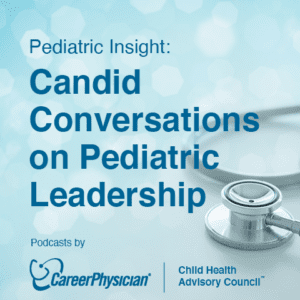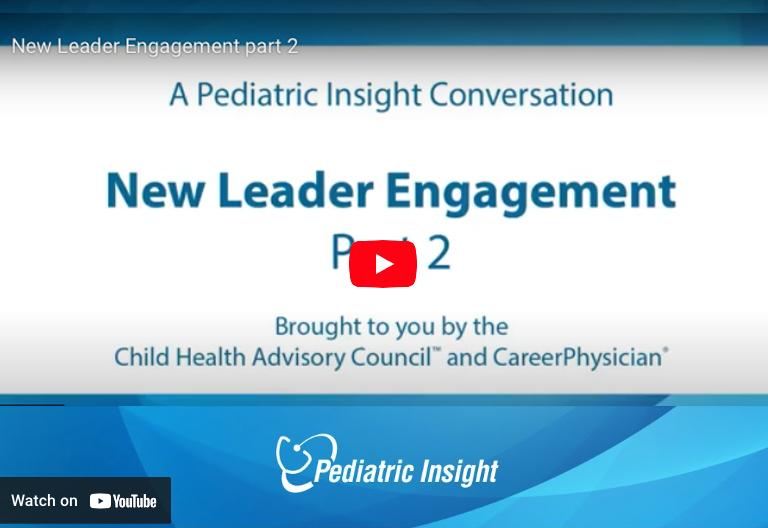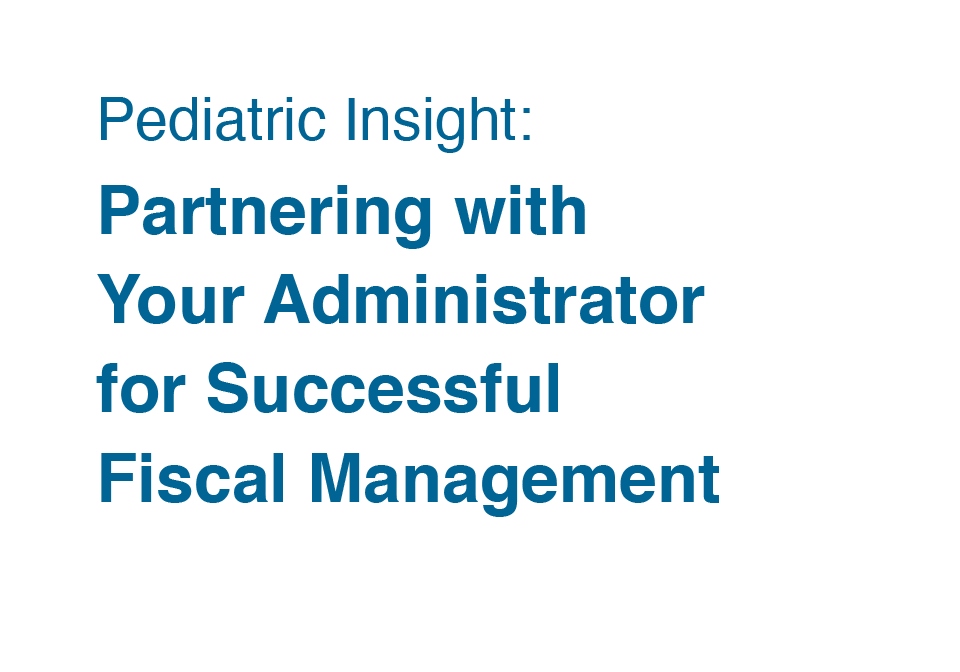
Duration: 00:26:42
Career Physician’s New Leader Engagement Program is a comprehensive approach to optimize a leader’s success in their new role. It begins with an experienced leader performing an extensive review of the institution and its component divisions and departments with their respective strengths, weaknesses and challenges. That same reviewer can then be an effective facilitator during the recruitment process based on that in-depth understanding of the institution and the area of specialty. The most powerful dividend of this program may be the potential for that same reviewer to serve as an advisor/coach for the individual selected to be the new leader. While this advisor/coach role may differ somewhat from the formal executive coaching role, the value of an outside advisor with specific knowledge of the situation, and who can serve as a confidant with no conflict of interests, may be powerful.
Subscribe: Apple Podcasts | Spotify
Watch the Conversation.
Meet the Panel.
HOST
A national expert in solutions for solving complex faculty leadership and subspecialty talent challenges.
Wesley D. Millican, MBA
CEO and Physician Talent Officer
Professor Emeritus and Chair Emeritus at the University of Washington School of Medicine. Read more.
Bruder Stapleton, MD
Pediatric Nephrologist
Professor of Pediatrics at the University of Michigan School of Medicine and C.S. Mott Children’s Hospital. Read more.
Valerie Opipari, MD
Pediatric Hematologist/Oncologist
Emeritus Professor and Surgeon in Chief at Seattle Children’s Hospital and the University of Washington. Read more.
Robert Sawin, MD
Pediatric Surgeon
President and Professor Emerita of SUNY Upstate Medical University. Read more.
Danielle Laraque-Arena, MD, FAAP
Child Abuse Pediatrics
Emeritus CEO, Penn State Health; Emeritus Dean and Professor of Pediatrics at Penn State University. Read more.
Craig Hillemeier, MD
Pediatric Gastroenterologist
Emeritus Professor and Chair of Pediatrics, University of Cincinnati College of Medicine and Cincinnati Children’s Hospital Medical Center. Read more.
Arnold (Arnie) Strauss, MD
Pediatric Cardiologist
Professor and Chair Emeritus of Pediatrics at Virginia Commonwealth University (VCU). Read more.
Bruce Rubin, MEngr, MD, MBA, FRCPC
Pediatric Pulmonologist
Professor Emerita of Pediatrics at the University of Washington School of Medicine. Read more.
Christine Gleason, MD
Neonatologist
Professor and Chair Emerita at Howard University College of Medicine in Washington, D.C. Read more.
Renée Jenkins, MD, FAAP
Adolescent Medicine Physician
Have a question or a topic you’d like us to discuss? Send us an email.
Listen to the Podcast.

Duration: 00:26:42
Success in leadership for academic medicine is much more complex and characterized by an accelerating pace of change. For new leaders, a robust support team is essential. To optimize that support, a thorough assessment of the individual leaders’ skills and experience, as well as the institutional environment is imperative at the beginning of their tenure. For that reason, a structured program or institutional review preceding the placement of a new leader can have great value. Once the institutional and leader assessments are completed, an ideal support team can be created to buttress areas where the leaders may face their greatest challenges. Furthermore, when leading a new team, a leader’s thorough understanding of different team members skills, experience, and styles of work and communication can be leveraged to optimize the success of the program, division, or department.
Subscribe: Apple Podcasts | Spotify
Watch the Conversation.
Meet the Panel.
HOST
A national expert in solutions for solving complex faculty leadership and subspecialty talent challenges.
Wesley D. Millican, MBA
CEO and Physician Talent Officer
Professor Emeritus and Chair Emeritus at the University of Washington School of Medicine. Read more.
Bruder Stapleton, MD
Pediatric Nephrologist
Professor of Pediatrics at the University of Michigan School of Medicine and C.S. Mott Children’s Hospital. Read more.
Valerie Opipari, MD
Pediatric Hematologist/Oncologist
Emeritus Professor and Surgeon in Chief at Seattle Children’s Hospital and the University of Washington. Read more.
Robert Sawin, MD
Pediatric Surgeon
President and Professor Emerita of SUNY Upstate Medical University. Read more.
Danielle Laraque-Arena, MD, FAAP
Child Abuse Pediatrics
Emeritus CEO, Penn State Health; Emeritus Dean and Professor of Pediatrics at Penn State University. Read more.
Craig Hillemeier, MD
Pediatric Gastroenterologist
Emeritus Professor and Chair of Pediatrics, University of Cincinnati College of Medicine and Cincinnati Children’s Hospital Medical Center. Read more.
Arnold (Arnie) Strauss, MD
Pediatric Cardiologist
Professor and Chair Emeritus of Pediatrics at Virginia Commonwealth University (VCU). Read more.
Bruce Rubin, MEngr, MD, MBA, FRCPC
Pediatric Pulmonologist
Professor Emerita of Pediatrics at the University of Washington School of Medicine. Read more.
Christine Gleason, MD
Neonatologist
Professor and Chair Emerita at Howard University College of Medicine in Washington, D.C. Read more.
Renée Jenkins, MD, FAAP
Adolescent Medicine Physician
Have a question or a topic you’d like us to discuss? Send us an email.

Success in leadership for academic medicine is much more complex and characterized by an accelerating pace of change. For new leaders, a robust support team is essential. To optimize that support, a thorough assessment of the individual leaders’ skills and experience, as well as the institutional environment is imperative at the beginning of their tenure. For that reason, a structured program or institutional review preceding the placement of a new leader can have great value. Once the institutional and leader assessments are completed, an ideal support team can be created to buttress areas where the leaders may face their greatest challenges. Furthermore, when leading a new team, a leader’s thorough understanding of different team members skills, experience, and styles of work and communication can be leveraged to optimize the success of the program, division, or department.
Listen to the Podcast.

Duration: 00:26:42
Recruitment is one of the most critical responsibilities of leaders to ensure the success of their departments. To avoid unsuccessful recruitment searches, all departments, regardless of their national esteem, must carefully prepare both the candidate and the department. With this preparation, departments can better present the opportunities that would attract the candidate, evaluate the cultural alignment, and to meet the candidate’s personal and professional goals. Personal respect for the candidate, not institutional arrogance, is required for successful recruitment. The Child Health Advisory Council (CHAC) and leadership of CareerPhysician discuss their perspectives on best practices to respect candidates during leadership search.
Subscribe: Apple Podcasts | Spotify
Watch the Conversation.
Meet the Panel.
HOST
A national expert in solutions for solving complex faculty leadership and subspecialty talent challenges.
Wesley D. Millican, MBA
CEO and Physician Talent Officer
Professor Emeritus and Chair Emeritus at the University of Washington School of Medicine. Read more.
Bruder Stapleton, MD
Pediatric Nephrologist
Professor of Pediatrics at the University of Michigan School of Medicine and C.S. Mott Children’s Hospital. Read more.
Valerie Opipari, MD
Pediatric Hematologist/Oncologist
Emeritus Professor and Surgeon in Chief at Seattle Children’s Hospital and the University of Washington. Read more.
Robert Sawin, MD
Pediatric Surgeon
President and Professor Emerita of SUNY Upstate Medical University. Read more.
Danielle Laraque-Arena, MD, FAAP
Child Abuse Pediatrics
Emeritus CEO, Penn State Health; Emeritus Dean and Professor of Pediatrics at Penn State University. Read more.
Craig Hillemeier, MD
Pediatric Gastroenterologist
Emeritus Professor and Chair of Pediatrics, University of Cincinnati College of Medicine and Cincinnati Children’s Hospital Medical Center. Read more.
Arnold (Arnie) Strauss, MD
Pediatric Cardiologist
Professor and Chair Emeritus of Pediatrics at Virginia Commonwealth University (VCU). Read more.
Bruce Rubin, MEngr, MD, MBA, FRCPC
Pediatric Pulmonologist
Professor Emerita of Pediatrics at the University of Washington School of Medicine. Read more.
Christine Gleason, MD
Neonatologist
Professor and Chair Emerita at Howard University College of Medicine in Washington, D.C. Read more.
Renée Jenkins, MD, FAAP
Adolescent Medicine Physician
Have a question or a topic you’d like us to discuss? Send us an email.

Recruitment is one of the most critical responsibilities of leaders to ensure the success of their departments. To avoid unsuccessful recruitment searches, all departments, regardless of their national esteem, must carefully prepare both the candidate and the department. With this preparation, departments can better present the opportunities that would attract the candidate, evaluate the cultural alignment, and to meet the candidate’s personal and professional goals. Personal respect for the candidate, not institutional arrogance, is required for successful recruitment. The Child Health Advisory Council (CHAC) and leadership of CareerPhysician discuss their perspectives on best practices to respect candidates during leadership search.

Every leader working with faculty and staff to define the mission and vision for the organization needs to articulate the core values and principles that will ignite and inspire the community. A #1 priority is providing a positive work and learning environment that supports the well-being of the organization. This conversation identifies key attributes of a healthy culture and gives examples of explicit messages that support a healthy culture.
Listen to the Podcast.

Duration: 00:26:42
Every leader working with faculty and staff to define the mission and vision for the organization needs to articulate the core values and principles that will ignite and inspire the community. A #1 priority is providing a positive work and learning environment that supports the well-being of the organization. This conversation identifies key attributes of a healthy culture and gives examples of explicit messages that support a healthy culture.
Subscribe: Apple Podcasts | Spotify
Watch the Conversation.
Meet the Panel.
HOST
A national expert in solutions for solving complex faculty leadership and subspecialty talent challenges.
Wesley D. Millican, MBA
CEO and Physician Talent Officer
Professor Emeritus and Chair Emeritus at the University of Washington School of Medicine. Read more.
Bruder Stapleton, MD
Pediatric Nephrologist
Professor of Pediatrics at the University of Michigan School of Medicine and C.S. Mott Children’s Hospital. Read more.
Valerie Opipari, MD
Pediatric Hematologist/Oncologist
Emeritus Professor and Surgeon in Chief at Seattle Children’s Hospital and the University of Washington. Read more.
Robert Sawin, MD
Pediatric Surgeon
President and Professor Emerita of SUNY Upstate Medical University. Read more.
Danielle Laraque-Arena, MD, FAAP
Child Abuse Pediatrics
Emeritus CEO, Penn State Health; Emeritus Dean and Professor of Pediatrics at Penn State University. Read more.
Craig Hillemeier, MD
Pediatric Gastroenterologist
Emeritus Professor and Chair of Pediatrics, University of Cincinnati College of Medicine and Cincinnati Children’s Hospital Medical Center. Read more.
Arnold (Arnie) Strauss, MD
Pediatric Cardiologist
Professor and Chair Emeritus of Pediatrics at Virginia Commonwealth University (VCU). Read more.
Bruce Rubin, MEngr, MD, MBA, FRCPC
Pediatric Pulmonologist
Professor Emerita of Pediatrics at the University of Washington School of Medicine. Read more.
Christine Gleason, MD
Neonatologist
Professor and Chair Emerita at Howard University College of Medicine in Washington, D.C. Read more.
Renée Jenkins, MD, FAAP
Adolescent Medicine Physician
Have a question or a topic you’d like us to discuss? Send us an email.

Financial management is often an area that physician leaders have not yet developed experience prior to assuming their leadership role. The complexity of clinical reimbursements, research funding sources and institutional compensations has greatly increased the management demands for physician leaders. Fortunately, department chairs, and most division chiefs, often have an administrator available to share this responsibility. In this conversation of members of CareerPhysician’s Child Health Advisory Council, experienced leaders reflect on the nature of this relationship and how it might be maximized.
Listen to the Podcast.

Duration: 00:26:42
Financial management is often an area that physician leaders have not yet developed experience prior to assuming their leadership role. The complexity of clinical reimbursements, research funding sources and institutional compensations has greatly increased the management demands for physician leaders. Fortunately, department chairs, and most division chiefs, often have an administrator available to share this responsibility. In this conversation of members of CareerPhysician’s Child Health Advisory Council, experienced leaders reflect on the nature of this relationship and how it might be maximized.
Subscribe: Apple Podcasts | Spotify
Watch the Conversation.
Meet the Panel.
HOST
A national expert in solutions for solving complex faculty leadership and subspecialty talent challenges.
Wesley D. Millican, MBA
CEO and Physician Talent Officer
Professor Emeritus and Chair Emeritus at the University of Washington School of Medicine. Read more.
Bruder Stapleton, MD
Pediatric Nephrologist
Professor of Pediatrics at the University of Michigan School of Medicine and C.S. Mott Children’s Hospital. Read more.
Valerie Opipari, MD
Pediatric Hematologist/Oncologist
Emeritus Professor and Surgeon in Chief at Seattle Children’s Hospital and the University of Washington. Read more.
Robert Sawin, MD
Pediatric Surgeon
President and Professor Emerita of SUNY Upstate Medical University. Read more.
Danielle Laraque-Arena, MD, FAAP
Child Abuse Pediatrics
Emeritus CEO, Penn State Health; Emeritus Dean and Professor of Pediatrics at Penn State University. Read more.
Craig Hillemeier, MD
Pediatric Gastroenterologist
Emeritus Professor and Chair of Pediatrics, University of Cincinnati College of Medicine and Cincinnati Children’s Hospital Medical Center. Read more.
Arnold (Arnie) Strauss, MD
Pediatric Cardiologist
Professor and Chair Emeritus of Pediatrics at Virginia Commonwealth University (VCU). Read more.
Bruce Rubin, MEngr, MD, MBA, FRCPC
Pediatric Pulmonologist
Professor Emerita of Pediatrics at the University of Washington School of Medicine. Read more.
Christine Gleason, MD
Neonatologist
Professor and Chair Emerita at Howard University College of Medicine in Washington, D.C. Read more.
Renée Jenkins, MD, FAAP
Adolescent Medicine Physician
Have a question or a topic you’d like us to discuss? Send us an email.

Many of our faculty may not recognize the many roles they play that require leadership perspective and skills. It is a tremendously exciting opportunity to help our faculty become the most effective leader they can be. There are many ways that clarity and education can be provided around these leadership opportunities. This discussion will highlight many of the successful modalities that leaders in academic medicine have utilized in developing and mentoring leadership skills in faculty.









